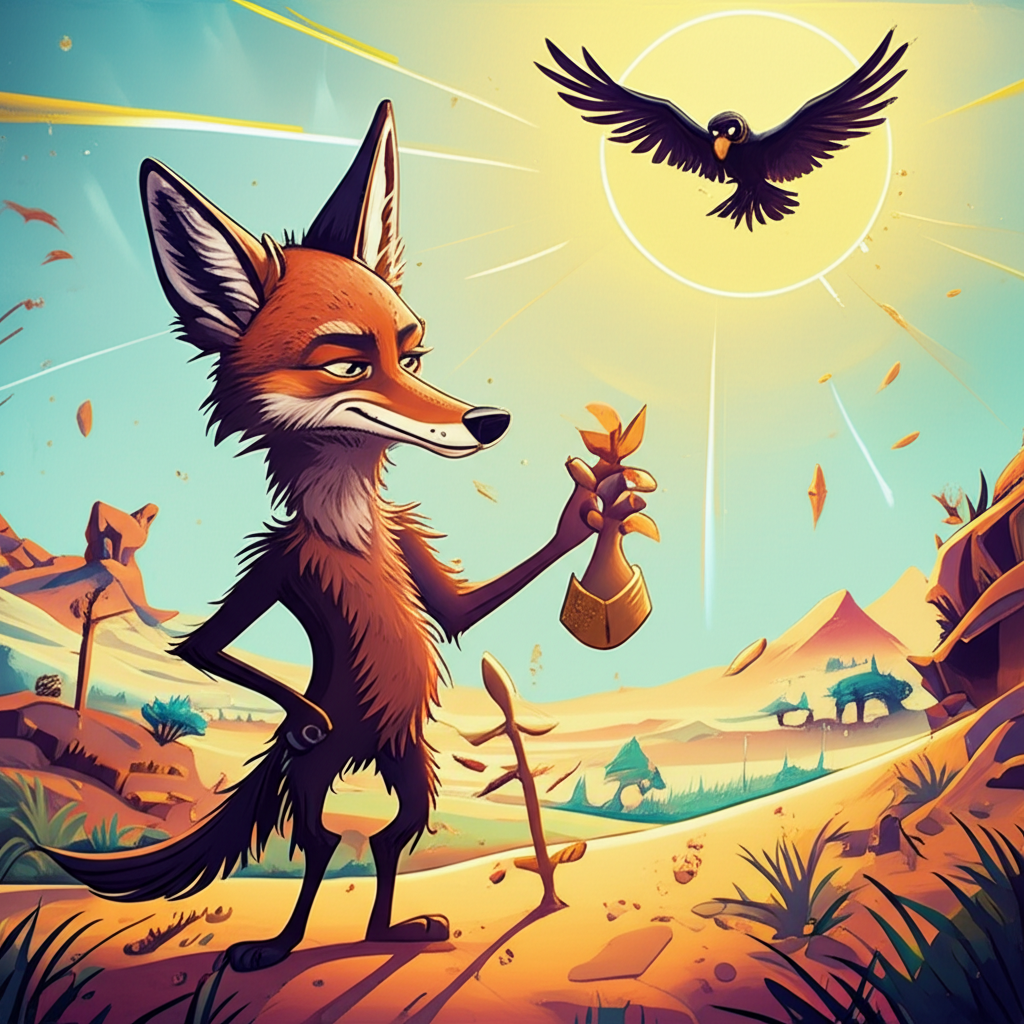
The vast, windswept landscapes of North America, from the towering Rockies to the sun-baked deserts of the Southwest, have long been home to rich tapestries of stories. These are not tales of historical fact, but rather the imaginative creations of ancient peoples, woven from their observations of the natural world, their hopes, their fears, and their deep need to understand their place within the cosmos. Among these enduring narratives are those that speak of Coyote, the wily trickster, and Raven, the powerful, shape-shifting bird, whose exploits are often intertwined with the very fabric of existence. One such legend, passed down through generations, tells of a time before light, when Raven, in an act of audacious thievery, stole the Sun, and how the world teetered on the brink of eternal darkness until Coyote, in his own peculiar fashion, helped restore it.
This myth originates from the diverse cultures of Indigenous peoples of the Pacific Northwest and parts of the Subarctic regions, including tribes like the Tlingit, Haida, and Kwakwaka’wakw. These were societies deeply connected to the rhythms of nature, where the cycles of day and night, the changing seasons, and the behavior of animals held profound significance. Their worldview was one where the natural and supernatural realms were not rigidly separated; spirits, animal beings, and human ancestors all played active roles in the unfolding of life. The world, as they understood it, was a place of intricate balance, often maintained by the actions of powerful beings whose motivations and actions might seem capricious to an outsider, but which served a purpose within their intricate cosmology. Life was a constant dance between order and chaos, light and shadow, and the stories of these ancient times served as a way to navigate and explain this delicate equilibrium.
Central to this narrative are two figures of immense symbolic weight: Coyote and Raven. Coyote, in many Indigenous traditions, is not a benevolent hero, nor a fearsome villain, but a complex and often contradictory character. He is the archetypal trickster – clever, resourceful, and driven by insatiable curiosity and a sometimes-selfish impulse. His actions can lead to disaster or to unexpected good, often through a combination of cunning and sheer luck. Symbolically, Coyote represents the wild, untamed spirit of nature, the boundary-crosser, and the catalyst for change, even if that change is born from mischief. He embodies the idea that sometimes, the most unlikely and flawed individuals can bring about necessary transformations.
Raven, on the other hand, is often depicted as a being of immense power and ancient wisdom, capable of shape-shifting and wielding influence over the elements. He is a figure of duality – sometimes a creator, sometimes a destroyer, often a trickster in his own right, but with a more primordial, cosmic authority. In this particular myth, Raven embodies the primal forces of the universe, the keeper of precious, essential elements. He is the powerful entity who holds the very source of light, representing the raw, untamed power that exists before it is harnessed and distributed for the benefit of all. His possessiveness over the Sun can be seen as a symbol of the initial, unshared abundance of the universe, a state that needs to be transformed for the world to flourish.
The story unfolds in a time of profound darkness. The world, it is said, was plunged into an unending night. The great boxes, filled with the light of the Sun, were hoarded by Raven in his grand lodge. The world was cold, the plants withered, and the creatures stumbled blindly, their lives a constant struggle against the oppressive gloom. Despair settled over the land like a heavy shroud.
Into this desolate landscape came Coyote, his fur a dusty grey, his eyes glinting with an insatiable curiosity and a perpetual hunger. He, like all others, suffered from the lack of light, but his nature was not one of quiet resignation. He heard the whispers of despair, the groans of the suffering, and a mischievous idea began to form in his sharp mind. He knew of Raven’s immense power and his jealously guarded treasures.
Coyote, with his characteristic stealth and cunning, set out to find Raven’s lodge. He observed the powerful bird, the guardian of the Sun, and devised a plan. He did not possess the brute strength of a warrior, nor the inherent magic of a shaman. His power lay in his wit, his adaptability, and his knack for exploiting weaknesses.
He transformed himself, as tricksters are wont to do, into a tiny speck of dust, carried on the wind, or perhaps a single, fallen pine needle. He insinuated himself into Raven’s domain, unseen and unheard. He waited, his senses alert, for his opportunity.
Raven, it is said, was often prone to vanity and a certain carelessness when he believed himself entirely secure. One day, as Raven was admiring his collection, perhaps preening his iridescent feathers, Coyote saw his chance. He transformed again, this time into a small, seemingly insignificant child, the son of a powerful chief who, in some tellings, was Raven’s own grandchild.
Raven, seeing the child, was delighted. He adored his grandson and would never deny him anything. The child, with innocent eyes and a plaintive cry, began to beg for the Sun. He pointed to the glowing orb, hidden within one of Raven’s intricately carved boxes. Raven, softened by the child’s pleas and his own affection, eventually relented. He allowed the child to hold the Sun, a ball of pure, radiant light.
But the child was Coyote in disguise. With a sudden burst of trickster energy, he snatched the Sun. It was far too bright, too powerful for him to truly control, but he managed to grasp it, his paws burning, his fur singed. He bolted from the lodge, the Sun clutched tightly, its brilliant light casting long, distorted shadows.
Raven, enraged, transformed back into his true form and pursued Coyote. The sky became a chaotic canvas of pursuit and evasion. Coyote, however, was not just running; he was strategically shedding the Sun, piece by piece, or perhaps rolling it along the mountain ridges. As he did, the first rays of dawn broke through the perpetual night, illuminating the world in tentative hues.
As Coyote continued his flight, he would toss the Sun into the sky, allowing it to roll and bounce, illuminating different parts of the land. This is how, in their imagination, these ancient peoples explained the dawn, the sunrise, and the movement of the sun across the sky. Raven, despite his power, could not reclaim the Sun once it was released into the vastness of the heavens, its brilliance now shared.
The story of Coyote and Raven stealing the Sun is rich with symbolism. It can be interpreted as a primal explanation for the origins of light and day. Raven’s hoarding of the Sun represents a state of undifferentiated, concentrated power, a cosmic treasure withheld. Coyote’s trickery, though born of self-interest and mischief, is the catalyst that breaks this monopoly. He embodies the chaotic, disruptive force that can ultimately lead to a more equitable distribution of resources and enlightenment. The act of stealing and releasing the Sun can also be seen as a representation of the ongoing struggle between control and freedom, between hoarding and sharing.
In the modern world, these ancient stories continue to resonate. Coyote and Raven appear in contemporary literature, art, and popular culture, often retaining their trickster archetypes. They are invoked in discussions of Indigenous storytelling traditions, providing insights into the cultural values, environmental observations, and philosophical underpinnings of these communities. In cultural studies, these myths are examined for their complex characterizations and their ability to explain natural phenomena through imaginative narratives.
It is crucial to remember, as we explore these fascinating tales, that they are indeed traditional stories, products of ancient human imagination and a deep connection to the natural world. As Muslims, we recognize that only Allah is the true Creator and Sustainer of all that exists, the source of all light and life. These stories, however, offer a valuable window into the cultural heritage and the rich storytelling traditions of the peoples who created them. They speak to our innate human desire to understand the world around us, to find meaning in its mysteries, and to pass down wisdom and wonder through the enduring power of narrative. The whispers of the sky, carried on the winds of time, remind us of the boundless capacity for human imagination and the enduring legacy of our ancestors’ tales.





